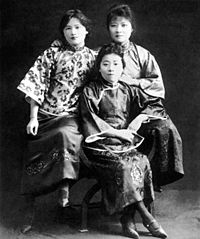စုန့်ညီအစ်မသုံးဖော်
ဤဆောင်းပါးကို မြန်မာဘာသာသို့ ပြန်ဆိုရန် လိုအပ်နေသေးသည်။
|
စုန့်ညီအစ်မသုံးဖော်

The Soong Sisters [Traditional Chinese]: 宋家姐妹, pinyin: Sòngjiā Jiěmèi, or 宋氏三姐妹 were three Hakka Chinese women who were, along with their husbands, amongst China's most significant political figures of the early 20th century. They each played a major role in influencing their husbands, which, along with their own positions of power, ultimately changed the course of Chinese history.
Their father was American-educated Methodist minister Charlie Soong, who made a fortune in banking and printing. Their mother was Ni Kwei-tseng (倪桂珍 Ní Guìzhēn), whose mother Lady Xu was a descendant of Ming Dynasty mathematician and Jesuit Xu Guangqi.[၁] All three sisters attended Wesleyan College in Macon, Georgia.[၂] Their three brothers were all high ranking officials in the Republic of China government, one of whom was T. V. Soong.
သမိုင်း[ပြင်ဆင်ရန်]

Throughout their lifetimes, each one of the sisters followed her own belief in terms of supporting the Kuomintang (KMT) or the Communist Party of China. In the 1930s, Soong Ai-ling and her sister Mei-ling were the two richest women in China at the time.[၃] Both of them supported the Nationalists, while Soong Ching-ling later sided with the CPC.
In 1937 when the Second Sino-Japanese war broke out, all three of them got together after a 10 year separation in an effort to unite the KMT and CPC against the Imperial Japanese army. Soong Ai-ling devoted herself to social work such as helping wounded soldiers, refugees and orphans. She donated five ambulances and 37 trucks to the army in Shanghai and the air force, along with 500 leather uniforms.[၃]

When the Japanese occupied Nanjing and Wuhan, the three sisters moved to Hong Kong. In 1940, they returned to Chongqing and established the Chinese Industrial Cooperatives, which opened job opportunities for people through weaving, sewing and other crafts. The sisters frequently visited schools, hospitals, orphanages, air raid shelters and aided war torn communities along the way.[၃] While both parties failed to unite at the most critical time in the 1940s, the sisters made a valiant effort in financing and assisting in all national activities.
All members of the song family: song ai-ling, song ching-ling, song zi-wen, song mei-ling, song zi-liang, song zi-an (from older to younger)
ညီအစ်မသုံးဖော်[ပြင်ဆင်ရန်]
| English name | Chinese name | Description |
|---|---|---|
| Soong Ai-ling | Simplified Chinese: 宋蔼龄 Traditional Chinese: 宋藹齡 Pinyin: Sòng Ǎilíng |
The eldest (1890–1973). Was married to the richest man and finance minister of China, H. H. Kung. |
| Soong Ching-ling | Simplified Chinese: 宋庆龄 Traditional Chinese: 宋慶齡 Pinyin: Sòng Qìnglíng |
The second in order of seniority (1893–1981). Was married to Father of Modern China and first President of the Republic of China, Sun Yat-sen in Japan on 25 October 1915. She became joint President of the People's Republic of China with Dong Biwu from 1968 to 1972 and Honorary President in 1981, just before the passing of the Constitution of 1982. |
| Soong May-ling | Simplified Chinese: 宋美龄 Traditional Chinese: 宋美齡 Pinyin: Sòng Měilíng |
The youngest (1898–2003). Was a prominent political leader in her own right, the wife and partner in power of the leader of the Kuomintang (KMT) , Generalissimo of the Chinese armies, and later President, Chiang Kai-shek. |
Their marriages and alleged motivations have been summarized in the Maoist saying "One loved money, one loved power, one loved her country" (တရုတ်: 一個愛錢、一個愛權、一個愛國; ပင်ယင်: Yīgè ài qián, yīgè ài quán, yīgè àiguó) referring to Ai-ling, May-ling, and Ching-ling in that order[၄].
ယဉ်ကျေးမှု[ပြင်ဆင်ရန်]
- The Soong Sisters, the award winning 1997 Hong Kong film depicting the lives of the sisters.
- The Soong Sisters, a 1941 book by Emily Hahn.
ဆက်လက်ပြီး[ပြင်ဆင်ရန်]
ကိုးကား[ပြင်ဆင်ရန်]
- ↑ Catholic Dictionary entry for Xu Guangqi။ 11 September 2010 တွင် ပြန်စစ်ပြီး။
- ↑ The Soong Sisters။ History of the College။ 27 September 2011 တွင် မူရင်းအား မော်ကွန်းတင်ပြီး။ 3 October 2011 တွင် ပြန်စစ်ပြီး။
- ↑ ၃.၀ ၃.၁ ၃.၂ Peterson, Barbara Bennett (ed.). (2000). Notable Women of China: Shang Dynasty to the Early 20th Century. M.E. Sharp publishing. ISBN 076560504X.
- ↑ Sandy Donovan, "Madame Chiang Kai-Shek: Face of Modern China", Compass Point Books, 2007
- Soong Dynasty by Sterling Seagrave, Sidg. & J, 1985, ISBN 978-0283992384
အပြင် လင့်[ပြင်ဆင်ရန်]
| ဝစ်ရှင်နရီမှ အဓိပ္ပာယ်ဖွင့်ဆိုချက်များ | |
| Commons မှ မီဒီယာများ | |
| ဝီကီသတင်းမှ သတင်းများ | |
| ဝီကီကိုးကားချက်မှ အဆိုအမိန့်များ | |
| ဝီကီရင်းမြစ်မှ ရင်းမြစ်စာသားများ | |
| ဝီကီစာအုပ်မှ ပြဋ္ဌာန်းစာအုပ်များ | |
| ဝီကီတက္ကသိုလ်မှ လေ့လာနိုင်သော အကိုးအကားများ | |
- General Introduction Archived 27 September 2011 at the Wayback Machine. by Wesleyan College

